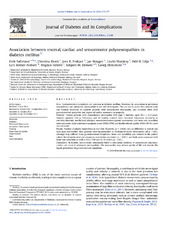| dc.contributor.author | Søfteland, Eirik | en_US |
| dc.contributor.author | Brock, Christina | en_US |
| dc.contributor.author | Frøkjær, Jens B. | en_US |
| dc.contributor.author | Brøgger, Jan C. | en_US |
| dc.contributor.author | Madácsy, László | en_US |
| dc.contributor.author | Gilja, Odd Helge | en_US |
| dc.contributor.author | Arendt-Nielsen, Lars | en_US |
| dc.contributor.author | Simrén, Magnus | en_US |
| dc.contributor.author | Drewes, Asbjørn M. | en_US |
| dc.contributor.author | Dimcevski, Georg Gjorgji | en_US |
| dc.date.accessioned | 2014-12-10T14:22:26Z | |
| dc.date.available | 2014-12-10T14:22:26Z | |
| dc.date.issued | 2014 | eng |
| dc.identifier.issn | 1056-8727 | |
| dc.identifier.uri | https://hdl.handle.net/1956/8895 | |
| dc.description.abstract | Aims: Gastrointestinal complaints are common in diabetes mellitus. However, its association to peripheral sensorimotor and autonomic neuropathies is not well investigated. The aim was to assess skin, muscle, bone and visceral sensitivity in diabetes patients with sensorimotor neuropathy, and correlate these with gastrointestinal symptoms and degree of cardiac autonomic neuropathy. Methods: Twenty patients with sensorimotor neuropathy (65% type 2 diabetes, aged 58.3 ± 12.0 years, diabetes duration 15.8 ± 10.0 years) and 16 healthy controls were recruited. Cutaneous sensitivity to von Frey filaments, mechanical allodynia, muscle/bone/rectosigmoid sensitivities, and heart rate variability were examined. Gastrointestinal symptom scores (PAGI-SYM) and health-related quality of life (SF-36) were also recorded. Results: Patients displayed hypesthesia to von Frey filaments (p = 0.028), but no difference to muscle and bone pain sensitivities. Also, patients were hyposensitive to multimodal rectal stimulations (all p < 0.05), although they suffered more gastrointestinal complaints. Heart rate variability was reduced in the patient cohort. Rectal mechanical and cutaneous sensitivities correlated (p < 0.001), and both were associated with heart rate variability as well as PAGI-SYM and SF-36 scores (p < 0.01). Conclusions: In diabetic sensorimotor neuropathy there is substantial evidence of concomitant cutaneous, cardiac and visceral autonomic neuropathies. The neuropathy may reduce quality of life and explain the higher prevalence of gastrointestinal complaints. | en_US |
| dc.language.iso | eng | eng |
| dc.publisher | Elsevier | eng |
| dc.rights | Attribution-NonCommercial-NoDerivs CC BY-NC-ND | eng |
| dc.rights.uri | http://creativecommons.org/licenses/by-nc-nd/3.0/ | eng |
| dc.subject | Diabetes | eng |
| dc.subject | Peripheral neuropathy | eng |
| dc.subject | autonomic neuropathy | eng |
| dc.subject | visceral | eng |
| dc.subject | heart rate variability | eng |
| dc.subject | Experimental | eng |
| dc.subject | Pain | eng |
| dc.subject | Gastrointestinal | eng |
| dc.title | Association between visceral, cardiac and sensorimotor polyneuropathies in diabetes mellitus | en_US |
| dc.type | Peer reviewed | |
| dc.type | Journal article | |
| dc.date.updated | 2014-12-08T15:11:05Z | en_US |
| dc.description.version | publishedVersion | en_US |
| dc.rights.holder | Copyright 2014 Elsevier Inc. | |
| dc.identifier.doi | https://doi.org/10.1016/j.jdiacomp.2013.10.009 | |
| dc.identifier.cristin | 1109501 | |
| dc.source.journal | Journal of diabetes and its complications | |
| dc.source.40 | 28 | |
| dc.source.14 | 3 | |
| dc.source.pagenumber | 370-377 | |
| dc.subject.nsi | VDP::Medical sciences: 700::Clinical medical sciences: 750::Endocrinology: 774 | eng |
| dc.subject.nsi | VDP::Medisinske fag: 700::Klinisk medisinske fag: 750::Endokrinologi: 774 | nob |

